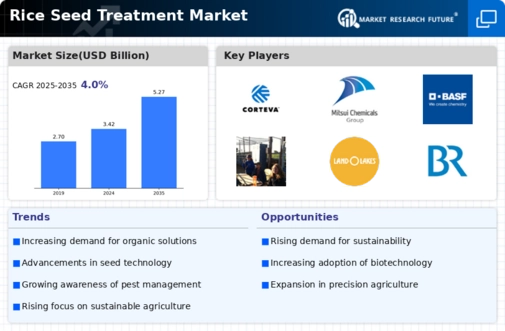Government Initiatives and Support
Government policies and initiatives significantly influence the Global Rice Seed Treatment Market Industry. Many countries are implementing programs to promote sustainable agricultural practices, including the use of treated seeds. These initiatives often include financial incentives for farmers to adopt innovative seed treatments that enhance crop productivity. For instance, subsidies for seed treatment products can lower the cost barrier for farmers, encouraging wider adoption. As a result, the market is expected to grow at a CAGR of 4.01% from 2025 to 2035, reflecting the positive impact of supportive government policies on the rice seed treatment sector.
Growing Awareness of Crop Protection
There is a growing awareness among farmers regarding the importance of crop protection in the Global Rice Seed Treatment Market Industry. Farmers increasingly recognize that untreated seeds can lead to significant losses due to pests and diseases. This awareness drives the adoption of seed treatments that provide a protective barrier against these threats. Educational campaigns and extension services play a crucial role in disseminating information about the benefits of seed treatments. As farmers become more informed, the demand for treated seeds is likely to rise, contributing to the overall growth of the market and enhancing food security.
Rising Global Population and Food Demand
The rising global population is a critical driver of the Global Rice Seed Treatment Market Industry. As the world population continues to grow, the demand for rice as a staple food increases correspondingly. This trend necessitates the adoption of agricultural practices that enhance productivity, including the use of treated seeds. Farmers are compelled to adopt innovative solutions to meet this burgeoning demand. The market's projected growth to 5.27 USD Billion by 2035 underscores the urgency of addressing food security challenges through improved agricultural practices, including effective seed treatments.
Increasing Demand for High-Yield Varieties
The Global Rice Seed Treatment Market Industry experiences a surge in demand for high-yield rice varieties, driven by the need to enhance food security. As populations grow, the pressure to produce more rice intensifies. For instance, the market is projected to reach 3.42 USD Billion in 2024, reflecting this growing demand. Farmers increasingly adopt seed treatments to improve germination rates and protect against pests and diseases, thereby maximizing yield potential. This trend indicates a shift towards more sustainable agricultural practices, as treated seeds can lead to reduced pesticide usage and improved crop resilience.
Technological Advancements in Seed Treatment
Technological innovations play a pivotal role in the Global Rice Seed Treatment Market Industry. Advances in seed treatment technologies, such as the development of bio-based treatments and precision application methods, enhance the effectiveness of seed treatments. These innovations not only improve seed performance but also align with environmental sustainability goals. For example, the introduction of microbial seed treatments has shown promise in enhancing plant health and resilience. As the industry evolves, these technologies are likely to drive market growth, with projections indicating a market value of 5.27 USD Billion by 2035, highlighting the potential for continued investment in research and development.




















